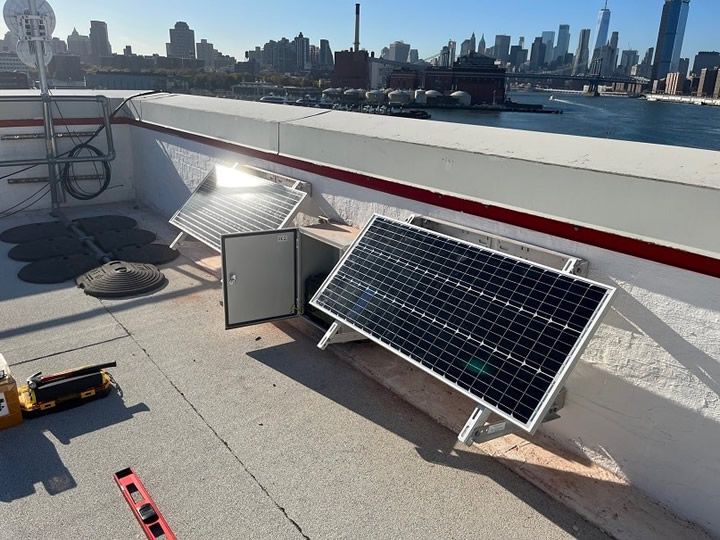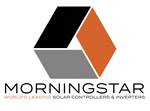Through a pilot program underway in the Brooklyn Navy Yard, solar design firm Voltaic Systems is working with NYC’s FloodNet cooperative to potentially bring greater security to neighborhoods throughout the metropolitan area.
 Using Solar-Powered Flood Monitoring Systems to Make New York City Safer
Using Solar-Powered Flood Monitoring Systems to Make New York City Safer

Case Study from | Morningstar
Summary
Through a pilot program underway in the Brooklyn Navy Yard, solar design firm Voltaic Systems is working with NYC’s FloodNet cooperative to potentially bring greater security to neighborhoods throughout the metropolitan area.
Project overview: a “proof of concept” solar-powered IoT Gateway system for flood monitoring networks, designed by Voltaic Systems and deployed in the Brooklyn Naval Yard in NYC
System components include:
- 2 100W solar panels
- 1 Apex 12V 120 Ah lead-acid battery
- 1 Morningstar SunSaver MPPT solar charge controller
- Mikrotik LtAP LR9 LTE Gateway
Situation
Unfortunately, between climate issues and denser populations in at-risk, prone areas, flooding is developing into an immense safety and economic challenge this century.
The National Oceanic and Atmospheric Administration (NOAA) estimates that tidal-induced flooding alone has increased 50% over the past 20 years, much of that driven by shifting coastal conditions. Since the 1980s, over 300 weather/climate disasters on record have cost the United States more than 2 trillion dollars—and the average cost of each major flooding event is now at $4.7 billion.
While agencies including NOAA and the USGS (United States Geological Service) do a good job monitoring potential for flooding in both coastal and interior areas that are vulnerable, the technologies used and data collected are often focused on downstream activity— for example, at the points where excess water from tidal surges drains into basins, or the points where excess water from streams and rivers flow into the oceans or lakes. While that’s critical, so too is understanding flooding conditions at the micro-level, in specific neighborhoods and streets. During a storm or other event these can vary considerably—a back-up that can quickly flood a neighborhood might go unnoticed at a conventional monitoring station downstream.
Solution
The FloodNet Cooperative was created to make sure that emergency personnel and first responders have an accurate idea of conditions at the neighborhood level in New York City. FloodNet (www.floodnet.nyc ) consists of researchers, various city agencies, educational institutions, and community leaders “to better understand the frequency, severity and impacts of flooding” and to aid local residents in planning and coping strategies. FloodNet drills down to the street level in neighborhoods “vulnerable to high tides, storm surge, and stormwater runoff”—all critical factors that can make all the difference in an emergency.
Monitoring at such a dispersed and diversified neighborhood level requires a number of “micro-monitoring” stations placed throughout the at-risk areas. The FloodNet network in the NYC area consists of over 50 sensor stations, augmented by 10 tidal monitoring stations maintained by USGS and NOAA. Unlike conventional flood monitoring schemes which depend on gauges and volumetric sensing, the FloodNet sensors use the innovative method of bouncing ultrasonic signals off the surface of any water present, measuring that against the known ground conditions to more accurately determine depth. Through them, anyone can monitor local flood conditions through their real-time data dashboard, featuring both a map viewer and sensor list page, at https://dataviz.floodnet.nyc/
However, one challenge is that the very nature of catastrophe-driven flooding conditions is that this is precisely when grid electricity is also the most vulnerable. New York City learned this all too well during storms and hurricanes in the past years. Any monitoring network should have an independent source for an electricity supply, as well as energy storage for enough autonomy to continue functioning during an extended power outage.
For the FloodNet project, the power solution was two-fold. First, the network is based on the LoRaWAN communications protocol, an abbreviation of “Long Range Wide Area Network” The LoRaWAN communication platform and protocol uses spread-spectrum modulation techniques similar to the ones in other wireless communications schemes; its combination of low-frequency, low bit-rate operation make it exceptionally efficient for long-range communications with very low power consumption. The Things Network, a global collaborative dedicated to LoRaWAN solutions, provided the network server to deliver the type of secure, low bit-rate long-range communications FloodNet needed.
Second, to provide network resiliency under catastrophic flood conditions (such as during a massive weather emergency) the project worked with Voltaic Systems, a provider of remote charging solutions for IoT devices and systems. Voltaic’s track-record and experience in portable solar charging systems in particular—going back to 2007— made them an ideal resource to conceptualize, design and build a fully-independent solar-powered IoT Gateway capable of supporting the FloodNet network.
The location of the first IoT Gateway deployment was the Brooklyn Naval Yard, an icon of U.S. naval history going back to 1801 and now a center for urban manufacturing and technology innovation, housing over 500 businesses. Co-owner Jeff Crystal explains the parameters of, and considerations behind, such a system. “We built the system to have plenty of capacity during the shortest days of the year. The two 100 Watt solar panels are more than sufficient to run the 5 Watt continuous power consumption of the gateway and the 120Ah battery provides close to a week buffer during rainy stretches with little solar illumination.”
The Voltaic IoT Gateway system incorporates a Morningstar SunSaver MPPT charge controller, which has communications capabilities and can support off-grid systems over 500 Watts. On choosing the SunSaver MPPT for such a high-profile project, Jeff Crystal notes that “there were a lot of charge controller options out there. We can always test them for performance and efficiency, and determine if they are working properly or not. But we simply can’t test for whether or not they will still be working over the next 10 years as our customers expect. That’s where reputation comes in. Morningstar’s has been proven for over twice as long as we’ve been in business — and that is invaluable.”
Jeff sees this IoT testbed system leading to wide adoption of higher-powered solutions in the IoT customer space including other municipalities along with NYC as well as various agencies, research institutions, and security system users. “We see a lot more need for such systems capable of running continuously with ‘hands-off’ operation. This Proof-of-Concept project helps us better understand sizing, installation, and logistical improvements for future system build-outs.”
The content & opinions in this article are the author’s and do not necessarily represent the views of AltEnergyMag

Morningstar Corporation
With over 4 million products installed and sold since 1993-in some of the most extreme environments and mission-critical applications in the world-Morningstar Corporation is the world's leading supplier of solar controllers and inverters. The US-based, privately-owned company is headquartered in Newtown, Pennsylvania, with an engineering research and development center in Maryland, and a global network of dedicated, best-in-class distribution and manufacturing partners. With some three decades of consistent, independent ownership and management behind it, Morningstar today enjoys stability and staying power unique in the industry- a result of the high morale, independent culture carefully cultivated by its founders and their original vision.
Other Articles
Talking Intersolar with Morningstar
Morningstar's New SureSine Off-grid Inverter Line
Operating Principles for Lead Acid Batteries
More about Morningstar Corporation
Comments (0)
This post does not have any comments. Be the first to leave a comment below.
Featured Product

